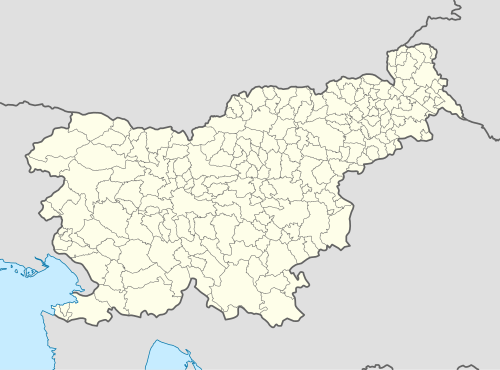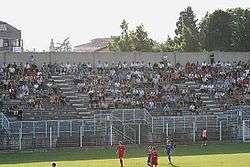Izola
| Izola | |
|---|---|
| City and Municipality | |
| Izola - Isola | |
 | |
 Location of the Municipality of Izola in Slovenia | |
 Izola Location of the Town of Izola in Slovenia | |
| Coordinates: 45°32′4″N 13°40′3″E / 45.53444°N 13.66750°ECoordinates: 45°32′4″N 13°40′3″E / 45.53444°N 13.66750°E | |
| Country |
|
| Region | Slovenian Littoral |
| Government | |
| • Mayor | Igor Kolenc |
| Area | |
| • Total | 28.6 km2 (11.0 sq mi) |
| Elevation | 29 m (95 ft) |
| Population (2002)[1] | |
| • Total | 15,900 (SURS, 2,011) |
| Time zone | CET (UTC+01) |
| • Summer (DST) | CEST (UTC+02) |
| Climate | Cfa |
| Source: Statistical Office of the Republic of Slovenia, census of 2002. | |
Izola (pronounced [ˈiːzɔla]; Italian: Isola) is an old fishing town and a municipality in southwestern Slovenia on the Adriatic coast of the Istrian peninsula. Its name originates from the Italian Isola, which means 'island'.
History
An ancient Roman port and settlement known as Haliaetum stood to the southwest of the present town, next to the village of Jagodje, as early as the 2nd century BC. The town of Izola was established on a small island by refugees from Aquileia in the 7th century . The coastal areas of Istria came under Venetian influence in the 9th century. The settlement was first mentioned in writing as Insula in a Venetian document entitled Liber albus in 932AD.[2] It became definitely the territory of the Republic of Venice in 1267, and the centuries of Venetian rule left a strong and enduring mark on the region. The Venetian part of the peninsula passed to the Holy Roman Empire of the German Nation in 1797 with the Treaty of Campo Formio, until the period of Napoleonic rule from 1805 to 1813 when Istria became part of the Illyrian provinces of the Napoleonic Empire. After this short period, during which Izola's walls were torn down and used to fill in the channel that separated the island from the mainland, the newly established Austrian Empire ruled Istria until November 1918.[3] Then Istria became part of the Kingdom of Italy, until Italian capitulation in September 1943, whereupon control passed to Germany. Izola was liberated by a naval unit from Koper at the end of April 1945. After the end of World War II, Izola was part of Zone B of the provisionally independent Free Territory of Trieste; after the de facto dissolution of the Free Territory in 1954 it was incorporated into Slovenia, then a part of Yugoslavia.[4] The newly defined Italo-Yugoslav border saw the migration of many people from one side to the other. In Izola's case, many Italian speakers chose to leave, and in their place Slovenian-speaking people from neighbouring villages settled in the town.[4]
In 1820, a thermal spring was discovered in Izola, leading to the town's earliest forms of tourism. Between 1902 and 1935 the Parenzana, a narrow-gauge railway line connected the town to Trieste and Poreč (known as Parenzo until 1947). Today Izola has many hotels near the sea, a famous discothèque (Embassy of Gavioli) Ambasada Gavioli, many art galleries, summer concerts, street performances and a movie festival.
There are plans to build an island between Izola and Koper in the future. A tunnel is also under construction to connect these two cities.
Population
The municipality has 15,900 inhabitants.[5] There are marginally more males (8,000) than females (7,900). By mother tongue, they identify themselves as Slovenes (10,059), Croatians (1,199), Italians (620) and Serbo-Croatians (562) with other smaller minorities.[6]
- Population by native language, 2002 census[7]
- Slovene 10,059 (69.14%)
- Croatian 1,199 (8.24%)
- Italian 620 (4.26%)
- Serbo-Croatian 562 (3.86%)
- Bosnian 537 (3.69%)
- Serbian 385 (2.65%)
- Macedonian 124 (0.85%)
- Albanian 93 (0.64%)
- Hungarian 19 (0.13%)
- German 10 (0.07%)
- Others and Unknown 941 (6.47%)
- Total 14,549
Municipality
The municipality of Izola[8] is officially bilingual, with both Slovene and Italian as official languages[9]
In addition to town of Izola, the municipality includes the villages of Baredi, Cetore (Italian: Settore), Dobrava, Jagodje (Italian: Valleggia), Korte (Italian: Corte), Malija (Italian: Malio), Nožed (Italian: Nosedo), and Šared (Italian: Saredo).[4]
Notable people
- Nino Benvenuti (born 1938), boxing champion
- Pietro Coppo (born 1469 or 1470; died 1555 or 1556), geographer and cartographer, worked in Izola
- Domenico Lovisato (1842–1916), geologist
- Darko Milanič (born 1967), football manager
- Vasilij Žbogar (born 1975), Olympic sailing champion
Sister cities
|
References
- ↑ Statistical Office of the Republic of Slovenia, census of 2002
- ↑ Izola-Isola municipal website
- ↑ Entry for Izola in the Lonely Planet Guide to Slovenia
- 1 2 3 Izola Municipality site
- ↑ Slovenian Statistics Office site
- ↑ Slovenian Istria site
- ↑ Slovenian Statistics Office site, results of the 2002 census
- ↑ The Statute of Izola/Isola - page 77
- ↑ Decree on the implementation of bilingualism in the nationally mixed territory of the Municipality of Isola - from page 9
External links
| Wikimedia Commons has media related to Izola. |
- Izola, official page of municipality (in Slovene and Italian)
- Izola on Geopedia
- Izola.eu
